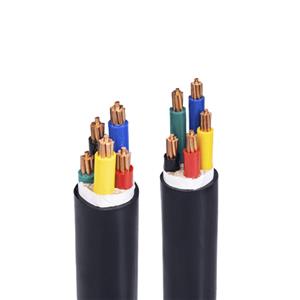The role of cable shielding
Shielded cable is a transmission line specially used to reduce the impact of external electromagnetic interference on signal lines. It wraps the signal line with a metal mesh braided layer. Common materials are red copper or tinned copper.
Shielded cable is mainly used to prevent external electromagnetic fields from interfering with power or communication lines, and also to prevent signals from radiating electromagnetic waves outward. Its shielding layer needs to be grounded so that external interference signals can be directed to the ground, thereby effectively reducing the impact on the equipment. The shielding layer is usually made of non-magnetic metals such as copper and aluminum, and is thin, much smaller than the skin depth of the metal (that is, the phenomenon that current tends to the surface of the conductor). The main effect of shielding does not come from the reflection or absorption ability of the metal, but from its grounding method. Different grounding methods will directly affect the shielding effect.

The common structures of shielded cables are ordinary structures and advanced structures. Ordinary structures are composed of insulating layers, shielding layers and wires. The advanced structure is based on the ordinary structure, adding signal wires and grounding wires to further improve the shielding effect. The function of the shielding layer is to isolate the electromagnetic noise source from sensitive equipment, cut off the propagation path of the noise source, and ensure the normal operation of the equipment.
Shielding can be divided into active shielding and passive shielding. Active shielding prevents the noise source from radiating outward, mainly shielding the noise source itself. Passive shielding prevents external noise sources from interfering with sensitive equipment, mainly protecting the equipment from external electromagnetic interference.
The working principle of the shielding layer is different from that of twisted pair cables, which offset external interference through the balance principle. Shielded cables use the reflection and absorption of electromagnetic waves by metal materials and the principle of skin effect to effectively shield the intrusion of external electromagnetic interference and prevent the radiation of internal signals.

In the design and use of shielded cables, special attention should be paid to different types of shield grounding methods to ensure the electromagnetic compatibility of the system. Shielded cables use special metal mesh braiding layers and grounding methods to effectively reduce external electromagnetic interference and protect sensitive equipment from noise. Through reasonable shield grounding design, the electromagnetic compatibility of the system can be maximized to ensure stable and reliable operation of the equipment.
- PVC-Insulated Cable
- 450/750V BV Single- Core Cu/PVC Cable
- 450/750V BVR Single- Core Cu/PVC Cable
- 300/500V Or 450/750V RV Single-Core Cu/PVC Flexible Cable
- 300/500V Or 450/750V RVV Multi-Core Cu/PVC/PVC Flexible Black Cable
- 300/500V Or 450/750V RVV Multi-Core Cu/PVC/PVC Flexible White Cable
- 300/500V Or 450/750V RVVP Multi-Core Cu/PVC/CWS/PVC Screened Flexible Cable
- 450/750V KVV Multi-Core Cu/PVC/PVC Control Cable
- 450/750V KVV22 Multi-Core Cu/PVC/STA/PVC Armoured Control Cable
- 450/750V KVVP Multi-Core Cu/PVC/CWS/PVC Screened Control Cable
- 450/750V KVVP2-22 Multi-Core Cu/PVC/CTS/STA/PVC Screened Armoured Control Cable
- 0.6/1KV PVC-Insulated PVC-sheathed Single-Core Power Cable
- 0.6/1KV PVC-Insulated PVC-sheathed Multi-Core Power Cable




